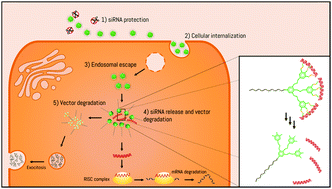Biodegradable PEG–dendritic block copolymers: synthesis and biofunctionality assessment as vectors of siRNA†
Abstract
One important drawback of most of the currently used dendrimers for biomedical applications is their high stability under physiological conditions that can result in cytotoxicity or complications induced by the accumulation of non-degradable synthetic materials in the organism. Particularly in the gene therapy field, vector stability can further hinder the intracellular release of the nucleic acid from the dendriplex, consequently leading to low transfection efficiencies. Therefore, biodegradable cationic dendritic structures have been eagerly awaited. However, the development of these dendritic nanocarriers is challenging because of the undesired and/or premature degradation observed during their synthesis and/or application. Here, we report new hybrid-biodegradable, biocompatible, non-toxic, and water-soluble azide-terminated PEG–GATGE dendritic block copolymers, based on a gallic acid (GA) core and triethylene glycol (TG) butanoate arms, incorporating ester bonds (E) at the dendritic arms/shell. Their successful functionalization by “click” chemistry with unprotected alkynated amines allowed complexation and delivery of siRNA. The hydrophobic character of the GATGE building unit confers to these hydrolyzable dendritic bionanomaterials a great ability to complex, protect and mediate the cellular internalization of siRNA. Moreover, the localization of the degradation points at the dendritic periphery, close to the complexed siRNA, was found to be important for nucleic acid release from the nanoparticles, rendering a significant improvement of the transfection efficiency compared to their hydrolytically stable PEG–GATG copolymer counterparts. The present study puts forward these biodegradable PEG–dendritic block copolymers not only as suitable vectors for nucleic acids, but also as new avenues for further developments exploring their use in theranostics.



 Please wait while we load your content...
Please wait while we load your content...